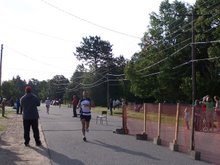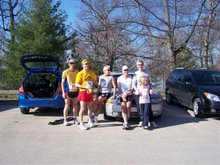The following article appeared on the Runners World Website
PLOW THROUGH THE SEASON
The best way to run strong in the spring is to keep running through the winter. Here's how:
By Ed Eyestone
PUBLISHED 11/28/2006
If you're looking for a way to keep your training consistent when the snow starts to fly, do what I did one record-setting bitter winter: Move to Mexico. If moving south of the border isn't an option, you still can maintain a high level of training throughout the winter months-without saying good-bye to speedwork, tempo runs, or long runs. You just need to be a little more flexible and creative with your running regimen.
Speedwork, for example, doesn't strictly mean a track workout. You can take some of your favorite track workouts on the road. In general, this means running for time instead of distance. Yes, this will only approximate the length of your repeats, but you'll still strengthen your aerobic and anaerobic systems, not to mention your legs.
Hard-core winter runners also have to become weather watchers and build flexibility into their training schedules. If a storm front looks to be rolling in on the weekend, get your long run done on Friday. An unexpected break in the weather might mean scheduling that hard workout today rather than the day after tomorrow. And any time you're running outdoors during these messy gray winter months, assume you're invisible to traffic. Dress like a Christmas tree, wearing as much reflective gear and as many light-producing products as possible. Always run against traffic, and constantly think about what you'll do if an oncoming car suddenly loses control and starts sliding toward you.
Once you've hit upon a good-weather day and strapped on your holiday light show, try any of the following winter variations on three classic workouts.
Mile Repeats: Take your mile repeats to a stretch of road where the traffic is light and the turns are infrequent. Start your watch and run the time it takes to normally complete a mile at your 5-K or 10-K pace. Run 4 or 5 of these repeats, taking 4 to 5 minutes recovery between them. Do this workout once a week, or alternate it with the mile breakdown every other week throughout the winter.
Mile Breakdown: A classic breakdown workout on the track might look like this: mile (1600), 1200, 1000, 800, 400, picking up the pace with each interval. For the off-track version, run hard for 10 minutes, 5 minutes, 3 minutes, 2 minutes, and 1 minute, and gradually pick up the pace with each drop in time. Take a one-to-one recovery (jog easy for the same length of time as the speed segment) after each repetition, and make sure you're running close to top speed on the final 1-minute burst.
Long Run: Combine a moderately long outdoor run with a moderately long treadmill run. Start outdoors by running for 75 to 90 minutes on an out-and-back or loop course. When you finish the outdoor leg, rehydrate, dry off, change all of your running clothes (even your shoes if they're wet), and hop on the treadmill for another 60 to 75 minutes. I like to keep the treadmill at 0-percent grade on these long runs to avoid aggravating the Achilles tendons. If you're running early in the morning, you could do the treadmill segment first so that you get the indoor portion done during the darkness and then hit the road once the sun has risen. But it's hard to pull on layers of running clothes even after drying off from your indoor workout. And beware that the winter air may seem much colder to you when you first head out after your treadmill session.
The Barrie RoadRunners
barrie.roadrunners@gmail.com
The Apparel blog can be found here
http://brrapparel.blogspot.com
Barrie RoadRunners Local Routes
Thursday, January 3, 2008
Winter Running Blaws??? Read this.
Posted by
Barrie RoadRunners
at
2:09 p.m.
![]()
Subscribe to:
Post Comments (Atom)



























No comments:
Post a Comment